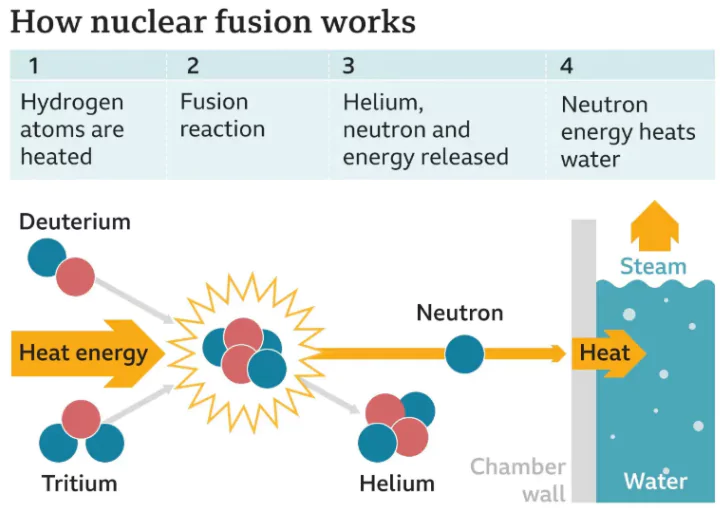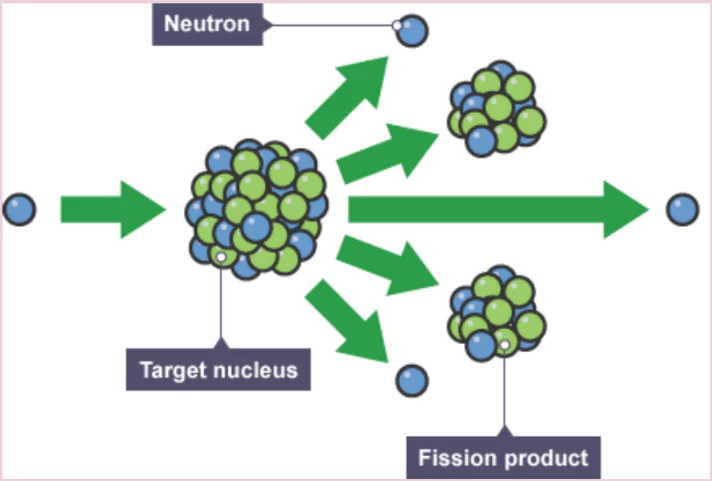The Experimental Advanced Superconducting Tokamak (EAST) reactor in China recently set a new record by maintaining its operational state for over 1,000 seconds (more than 17 minutes).
China’s EAST Reactor Breakthrough
- This recent achievement surpasses its previous record of 400 seconds set in 2023.
- Real-life electricity-generating reactors would require this state to be maintained for hours, even days, at a stretch.
Enroll now for UPSC Online Course
What is Nuclear Fusion?
- Nuclear fusion is the process where two light atomic nuclei combine to form a heavier nucleus, releasing enormous amounts of energy.
- It is the same process that powers the Sun and other stars, making it a potential clean and limitless energy source for the future.
How Nuclear Fusion Works?

- In fusion, two isotopes of hydrogen (Deuterium and Tritium) collide at extremely high temperatures.
- This forms a heavier helium nucleus, along with the release of neutrons and energy.
- The energy released is much greater than in nuclear fission (currently used in nuclear power plants).
Conditions Required for Fusion
- Temperature: Hundreds of millions of degrees Celsius, higher than the Sun’s core.
- State of Matter: At such temperatures, matter exists as plasma (a mix of charged particles).
- Containment: Plasma must be confined using powerful magnetic fields since no physical material can withstand such extreme heat.
Maintaining plasma stability is a major challenge. The slightest disruption in the magnetic field can collapse the reaction, which is why the recent breakthrough is important.
Check Out UPSC NCERT Textbooks From PW Store
Advantages of Nuclear Fusion
|
| Feature |
Benefit |
| Unlimited Fuel Supply |
Uses hydrogen isotopes (Deuterium from seawater and Tritium from lithium). |
| Zero Carbon Emissions |
No greenhouse gases, making it environmentally friendly. |
| No Long-Term Nuclear Waste |
Unlike fission, fusion does not produce hazardous radioactive waste. |
| High Energy Output |
1 gram of fusion fuel can produce as much energy as 10 tonnes of coal. |
| No Risk of Meltdown |
Unlike fission reactors, fusion does not have a risk of catastrophic failure. |
Challenges in Achieving Fusion Energy
- Extreme Temperature Requirements: Plasma must be heated and maintained at millions of degrees.
- Sustained Reaction Difficulty: Plasma confinement for long periods is unstable.
- High Initial Costs: Research and reactor construction require billions of dollars.
- No Commercial Fusion Yet: Current fusion experiments do not yet generate electricity.
Progress in Global Fusion Research
- International Thermonuclear Experimental Reactor (ITER), Cadarache, France: It is the world’s largest nuclear fusion research project.
- JET Laboratory, UK (2021): Produced 12 MW of electricity for 5 seconds, enough to power 10,000 homes.
- Lawrence Livermore National Laboratory, USA (2022): Achieved net energy gain for the first time, meaning the energy output was greater than the input.
- MIT Research (2023): Developed new materials that can withstand extreme conditions inside fusion reactors.
- China’s New Laser-Ignited Fusion Project (2024): Being developed to explore fusion energy and potentially aid thermonuclear weapons research.
- Helion (USA): Plans to generate 50 MW of electricity by 2028 and supply it to Microsoft.
- Commonwealth Fusion Systems (USA): Working with MIT to build a 400 MW grid-scale fusion plant by the early 2030s.
International Thermonuclear Experimental Reactor (ITER)
- ITER is the world’s largest nuclear fusion research project, aimed at demonstrating the feasibility of fusion as a clean and sustainable energy source.
- It is an international collaboration involving over 30 countries, including India.
- The project is being constructed in Cadarache, France, and is expected to be a key milestone in developing commercial nuclear fusion reactors.
Enroll now for UPSC Online Classes
Objectives of ITER
- Demonstrate Feasibility: Prove that nuclear fusion can be a practical energy source.
- Generate High Power: Produce 500 MW of fusion power from an input of 50 MW.
- Sustain Plasma for Long Duration: Maintain plasma confinement for extended periods.
- Test Key Technologies: Develop materials and mechanisms for future fusion reactors.
- Advance Scientific Knowledge: Provide insights into plasma behavior and fusion physics.
Future of Fusion Energy
- Although a commercial fusion reactor is unlikely before 2050, recent breakthroughs have increased optimism.
- Unlike solar and wind energy, fusion can provide unlimited, continuous, and clean power without dependency on weather conditions.
- As technology advances and investments grow, nuclear fusion could revolutionize the energy sector, making fossil fuels and even other renewables less relevant.
Nuclear Fission

- Nuclear fission is the process of splitting a heavy atom (like uranium or plutonium) into smaller parts.
- When a heavy atom splits, it releases a lot of energy and a few neutrons, which can split more atoms, creating a chain reaction.
- It’s used in nuclear power plants to generate electricity and in atomic bombs for explosive energy.
- It produces a lot of energy but also creates radioactive waste that needs careful handling.
|
Difference Between Nuclear Fusion and Nuclear Fission
|
| Feature |
Nuclear Fusion |
Nuclear Fission |
| Definition |
Two light atomic nuclei combine to form a heavier nucleus, releasing energy. |
A heavy atomic nucleus splits into two or more smaller nuclei, releasing energy. |
| Process |
Occurs naturally in stars like the Sun |
Used in nuclear power plants and atomic bombs. |
| Energy Output |
Produces significantly more energy than fission. |
Produces less energy compared to fusion. |
| Fuel Used |
Uses isotopes of hydrogen (deuterium & tritium). |
Uses heavy elements like uranium-235 and plutonium-239. |
| Waste Production |
Produces minimal radioactive waste, making it cleaner. |
Produces hazardous radioactive waste. |
| Reaction Conditions |
Requires extremely high temperatures (millions of degrees Celsius). |
Can occur at lower temperatures and controlled conditions. |
| Environmental Impact |
No greenhouse gas emissions; safe and clean. |
Produces radioactive waste and poses environmental risks. |
| Practical Usability |
Still under research; no commercial reactors yet. |
Used in nuclear power plants for electricity generation. |
| Risk Factor |
No risk of chain reaction or meltdown. |
Risk of nuclear accidents and radiation leaks. |
Ready to boost your UPSC 2025 preparation? Join PW’s UPSC online courses today!
![]() 30 Jan 2025
30 Jan 2025

